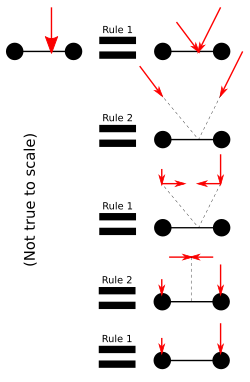Why a body does not rotate if force is applied on the centre of mass?
The question is: Why does it rotate if it is not applied to the center of a mass?
First we look at two rules that students of mechanical engineering (I don't know about physics) learn at university:
- Multiple forces applied to the same point of a solid body have the same effect as a single force applied to that point whose magnitude and direction is the same as the the vector sum of the other forces. (See pos. 1 in my image.)
- A force applied to some point of a solid body has the same effect as a force with the same direction and magnitude applied to another point of that body along the same axis. (Sorry, my English is not the best. But pos. 2 in my image should make this clearer.)
In university, these two rules are used to prove that the formula of momentum ($M = r\times F$) is valid...
However, we can use the same methods used in that proof to prove that a body will rotate if the force is not applied to the center of gravity:
We do that for a very simple body because otherwise we would require integral calculation: We have a body like a dumbbell: Some bar that has nearly no mass in the middle but all mass is concentrated in the two endpoints. (Pos. 3 and 4 of my image)
We do some vector calculations (shown in my second drawing) to prove that one force applied to some point of the body has the same effect as two forces applied to the ends of the body (where the mass is).
If the single force is applied to the center of the bar (if both masses at the ends are equal, this is the center of the mass), the two forces having the same effect as the single force have the same magnitude. (Pos. 3)
However, if the single force is not applied to the center of the bar, the two forces do not have the same magnitude. (Pos. 4)
You may say that the left force accelerates the mass on the left end of the bar while the right force accelerates the mass at the right end of the bar.
Because the forces have a different magnitude (but the masses are equal), the acceleration is different and therefore the velocity will be different after a short time.
If two points of a solid body move with a different velocity, this means that the solid body is rotating.
I am looking for intuition behind this.
Most intuitive would be applying a single force at one end of the bar...
Drawings
Positions 1-4 in my answer:

Vector operations required for the proof:




